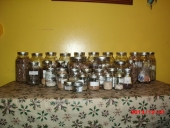
 1
1




“Birds born in a cage think flying is an illness.” ― Alejandro Jodorowsky
 7
7





 3
3








Robin Katz wrote:Seed saving isn't as obvious as most people think so your question isn't dumb at all. There's a lot of variables.
I always harvest the whole flower stalk and let it dry on paper towels or some newspaper to catch any of the tiny seeds, then put the stalk and any loose seeds into a paper bag for storage. If the flower stalk is not completely dry and you put it in an airtight container, it will probably mold, even with the dry milk, which I'd personally use for cooking.
I saved a bunch of seeds once and stored them in a ziplock baggie. I swear they were dry when they went in but everything went moldy. Since then it's paper bags for me. Better for the environment too.
“Birds born in a cage think flying is an illness.” ― Alejandro Jodorowsky




Joseph Lofthouse wrote:
I allow the flower stems to dry a long time in the field. Then allow them to dry even longer in a paper sack with an open top. When the whole flower stalk is thoroughly dry and crunchy, then I separate the seeds from the rest of the flower stalk.
The seeds certainly don't need to be separated from the dried up flower parts. I usually separate them by winnowing, or running through a colander/screen, or both.
“Birds born in a cage think flying is an illness.” ― Alejandro Jodorowsky
 1
1




 1
1




Standing on the shoulders of giants. Giants with dirt under their nails




Robin Katz wrote:Emily,
The Ukranian woman's seeds were just the seeds, right? I think that is the difference here. If you harvest the mature flower tops with the seeds, the vegetable matter holds a lot of moisture. If you separate the seeds the way Joseph described, then the seeds hold far less water since they are thoroughly dried out and dormant.
Robin Katz wrote:
On a different note, you said you dry your herbs in the oven. In my experience, this method results in a less pungent dried herb due to the volatile components being driven off by the heating process. I now dry my herbs on a towel in the garage where it is cool, dry, and dark-ish. Even the parsley keeps a really strong flavor this way. I dry a lot of medicinal herbs too and processing conditions with those are very important in order to keep the quality high. Heat, light, and oxygen all have a tendency to deteriorate the quality of culinary and medicinal herbs.
“Birds born in a cage think flying is an illness.” ― Alejandro Jodorowsky




Tj Jefferson wrote:I’m much lazier. I do basil in the same place each year, and I usually just let a few go to seed and let them stratify in place. If I want a new are I take the whole seed head and put it where they will be next spring. This works fantastic for cilantro, parsley, basil, dill. Only OK for others I have tried.
“Birds born in a cage think flying is an illness.” ― Alejandro Jodorowsky

|
Would you like to try a free sample? Today we are featuring tiny ads:
turnkey permaculture paradise for zero monies
https://permies.com/t/267198/turnkey-permaculture-paradise-monies
|

